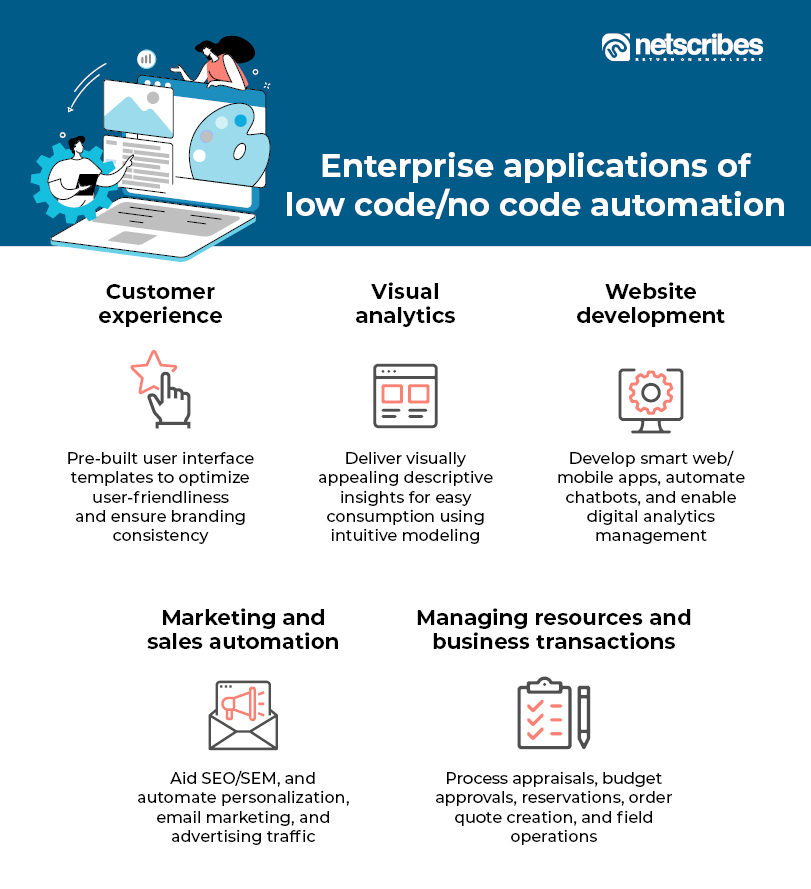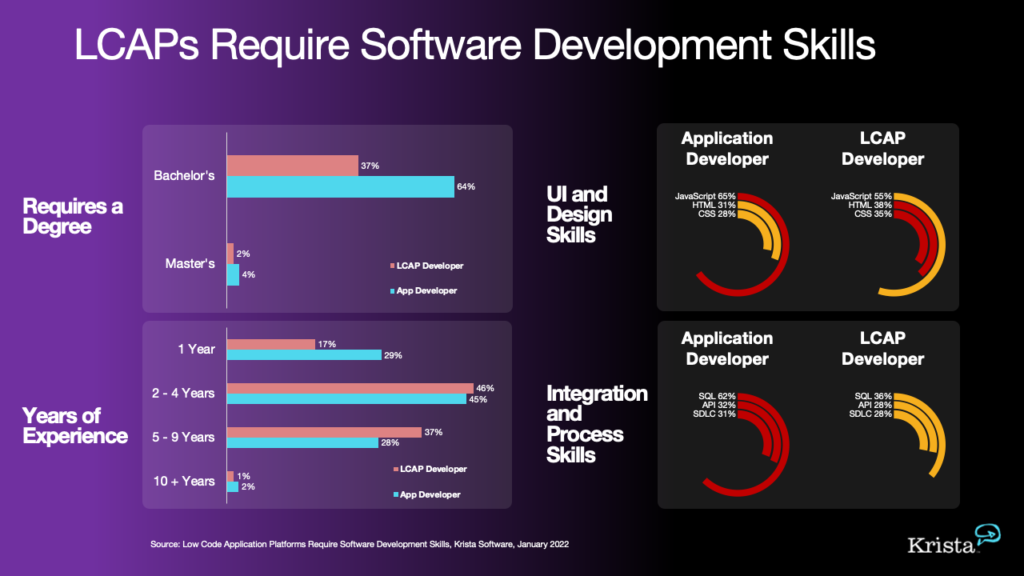Free Info On Picking Low-Code Platform Recommendations
Free Info On Picking Low-Code Platform Recommendations
Blog Article
The Ease Of Use Of Low-Code Apps Is One Of The Biggest Benefits.
Low-code application development significantly improves accessibility for non-developers, often called "citizen developers," due to several key factors. Intuitive Visual Interfaces:
Drag-and-Drop Builders: Low-code platforms come with drag-and-drop interfaces, which allow non-developers create apps without having to write any code. The development process is now more accessible to those who have no technical background.
WYSIWYG: WYSIWYG editors are "What you see is what you Get" editors that let users to design workflows and interfaces similar to the finished product. It makes it much simpler to understand and use.
Simple design of Workflow and Logic
Visual Workflow Modeling: Users are able to develop business procedures, application logic, and flowcharts through models as well as visually-designed flowcharts. These techniques are more intuitive than traditional coding methods.
Pre-built Logical Components: A lot of low-code platforms come with pre-built components for logic (e.g. loops, conditions), that can be easily configured. This eliminates the requirement to write complex programs.
Reusable templates and components:
Libraries of prebuilt templates: Low-code platforms often offer templates from libraries for popular application types. This allows non-developers the ability to begin with a solid foundation and then modify it according to their needs.
Reusable Modules and Widgets With the help of the reuse of modules and widgets users can streamline the creation process, while also reducing the requirements for technical expertise.
Guided Development and Tutorials
Step-by-Step Guides: Platforms frequently provide guided development pathways, online tutorials, or on-screen instructions to assist those who are not developers in developing applications.
Interactive Tutorials Interactive tutorials are hands-on and interactive and help users learn by doing. This boosts their confidence in the platform.
Integration with Existing Tools:
Seamless Integration: Low-code platforms are built to integrate seamlessly with the tools and systems in business (e.g. the CRM or ERP), which lets non-developers to develop applications that can work within existing workflows.
APIs Connectors, APIs: These tools simplify integration by allowing non-developers (or even end users) to connect their apps to external services.
Collaboration Features:
Team Collaboration: Features like real-time collaboration workspaces and shared workspaces make it feasible for non-developers to work effectively with developers, business analyst and other users.
Role Based Access Control: You can assign non-developers roles that correspond to the appropriate access level so that they can be part of the development process while not compromise on security or function.
Automated Debugging, Debugging, and Testing
Low-code platforms usually come with integrated testing and debugging tools that automates this process. Non-developers can now easily verify that their app is working correctly.
Error highlighting: The platform highlights issues and suggests fixes to help non-developers.
The capacity of low-code software to make development accessible for those who are not developers is its main benefit. With its intuitive, visually-focused tools as well as guided experiences, low-code platforms enable business users to be actively involved in the creation and maintaining applications, bridging the gap between business requirements and technical implementation. Check out the recommended Low-code Platform for application development examples for website tips including application modernisation, developing mobile apps, rad application development, cross platform mobile dev, app modernisation, rapid applications, lowcode no code, driver jdbc, application modernisation, develop web app and more.
Cost-Effectiveness Is Among The Many Advantages Of Developing Applications Using Low-Code.
Low-code app development offers numerous benefits, including cost efficiency. It is a popular option for businesses who want to optimize development budgets without compromising on quality. Here are a few of the most important benefits:
Less Coding Requirements: The low codes platforms remove the need for lengthy hand-coded apps. Developers will take less time and energy creating applications. This translates to lower costs for labor.
Fewer Developers: Because low-code development is quicker and simpler, there are fewer specialized developers needed. This will drastically reduce the need for costs for hiring and staffing.
Faster time to market:
Accelerated development cycles Visual development tools as well as prebuilt components offered by low-code platforms allow rapid application development. This allows businesses to get their products to launch faster. This will result in faster revenue growth and improve competitive positioning.
Rapid Prototyping: Businesses are able to quickly develop prototypes and then test them, reducing the amount of time needed during the development process and allowing faster iterations based on feedback from users.
Lower cost of maintenance:
Simpler Maintenance: Low-code platforms with their modular components and standardised components make them easier to maintain. This lowers the costs of ongoing maintenance.
Automated Updates. Many low-code platforms manage updates and patch automatically. Applications are secure and safe without requiring a lot of manual input.
Efficient Resource Utilization:
Platform contributions that are low-code let business users as well as others who are not developers to take part in the creation process. This democratization of the development process enables companies to tap into the expertise and talents of a wider number of employees.
Optimized Use of IT Resources: IT departments can focus on more strategic endeavors rather than being bogged down with mundane development tasks which can increase overall productivity and efficiency.
Scalable pricing models:
Subscription-Based Price: Many low code platforms offer flexible subscription-based pricing that scales according to usage. This lets businesses match their spending to their real needs and growth.
Pay-Asss-You-Go Option: Some platforms have pay-ass-you go options that guarantee that businesses only pay for the time they make use of resources. This can be especially helpful for startups and smaller businesses with limited budgets.
Reduced costs of third-party software:
Low-code platforms are often equipped with integrated functions that eliminate the requirement to purchase additional software or tools. This can help you save money on subscriptions and software licensing costs.
Pre-Built Integrations: The availability of pre-built integrations with popular platforms and services eliminates the requirement for custom-built development, thereby saving time and money.
Increased ROI
Increased Return On Investment A combination of rapid development and lower costs with an increased time to market can help businesses get higher return on their investment.
Improved Agility: Businesses can quickly adapt to market changes and customer needs, ensuring that they stay current and take advantage of new opportunities that arise.
Training costs are lower:
User-Friendly Interfaces: The simple user-friendly interfaces offered by low-code platforms can reduce the learning curve of new users, minimizing the need for extensive training programs.
Accessible Resources: Many low-code platforms offer extensive training materials, tutorials, and community support, further reducing the need for formal training and the associated expenses.
Collaboration can be streamlined.
Enhanced Collaboration Tools: Built-in tools for collaboration aid in better coordination and communication between team members, leading to improved development efficiency and less project overhead.
Unified Development Environment (UDE): A single, unifying development environment that streamlines workflows and reduces the costs and complexity of managing different tools and platforms.
Low-code development is cost effective because it lowers maintenance and development costs. It also accelerates time to market as well as optimizes utilization of resources. Pricing models are flexible. This combination of factors offers companies significant financial advantages and makes low-code an appealing option for businesses looking to make the most of their budgets for development, yet still creating robust and flexible applications. Check out the most popular Enterprise application development with Low-code Platform info for blog examples including rapid app development, multiplatform mobile app development, developing mobile apps, push notifications, app platforms, azure sql databases, low code platforms, build with docker, cross platform mobile development, rapid action development and more.
The Advantages Of Low-Code Development For Collaboration And Workflow
Low-code development of applications offers a variety of benefits in workflow and collaboration, making it the ideal option for companies who want to increase team productivity and streamlining development processes. Here are a few of the benefits that are most notable: Improved cross-functional collaboration:
Unified Development Environment (UDE): Low-code platforms provide an integrated development environment that enables everyone in the team, including developers and business analysts to collaborate effectively. This removes the barriers.
Visual Development Tools: The visual drag-and-drop feature of low-code tools makes it simpler for non-technical team members to be involved in the process of development, while ensuring that business requirements are accurately recorded and implemented.
Communication Enhanced
Real-Time Co-operation: Many platforms that use low-code support real-time collaboration features such as commenting, editing in parallel and instant feedback. They enable constant communication, reducing the amount of time needed for back and forth discussions.
Shared Workspaces : Teams are able to work in shared workspaces. They are able to view and edit the project components. This helps to ensure that everyone works towards the same goal.
The management of workflows has been simplified
Built-In Tools for Project Management: Platforms that are low-code often have integrated tools for managing projects that aid teams in planning, track, and manage their development initiatives. This includes tasks assignment, progress monitoring, and management of deadlines.
Workflow Automation - Automating routine tasks or workflows permits teams to concentrate their energy on more strategic initiatives and tasks which improve the overall efficiency of an organization.
More efficient Iteration cycles
Rapid Prototyping Low-Code platforms are great for speedy prototyping. Iterative development is also possible and allows teams to experiment, create and refine their applications within shorter time. This provides rapid feedback and improvements.
Support for Agile Development: Supporting agile methodologies allow teams to work continuously in sprints. This makes it simpler to change and deliver smaller incremental improvements to capabilities.
Accessibility for Non-Developers
Citizens Development: Lowcode platforms allow people who use business software (citizen developers) to design, modify, and maintain applications with no programming expertise. This helps to reduce the burden of IT and development departments, and allows them to react faster to business demands.
Training and Onboarding Intuitive interfaces and a wealth of training materials make it simpler for new members of the team to get up to speed and improve the overall cohesion within the team.
Centralized documentation Knowledge sharing, dissemination and centralization:
Low-code platforms usually have the ability to create, maintain and storing documentation within their platforms. This allows all project details to be stored in a central location and easily accessed.
Knowledge Repositories. Teams can set up repositories for knowledge, including templates and reusable parts. This can facilitate sharing of knowledge and will reduce duplication.
Consistency, Standardization and Standards:
Standardized Components: The use pre-built, standard components guarantees uniformity across different applications and makes it easier for team members to understand and work on different parts of a project.
Compliance and governance Frameworks built-in for governance ensure that all applications are designed in accordance to organizational standards, regulatory requirements, and standards for quality. They minimize the chance of not being compliant and ensure that applications meet the requirements of the standards.
Feedback and Improvement Loops
Integrated Feedback Systems: Low-code platforms have integrated feedback systems that permit users to give feedback to the applications. Feedback can later be used in the development of the applications.
Continuous Improvement: The ability to rapidly test and deploy changes based on feedback assures the continuous improvement of apps that are in line with the needs of users and business goals.
Visualization of Reporting:
Real-Time Analysis: Analytics and reporting tools integrated into the software give real-time information on the progress of projects, user interaction and performance. This allows data-driven decision making.
Visual Workflow Maps: Tools to map workflows or processes are helpful for teams to understand their processes. They can also identify bottlenecks, and areas that need improvement.
Low-code application development can be a very effective tool for collaboration and workflow. It connects different teams, streamlines communication, and automates processes. This fosters a more collaborative and efficient development environment that ultimately leads to higher-quality applications and better alignment with business objectives.